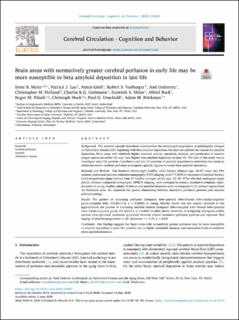Please use this identifier to cite or link to this item:
https://doi.org/10.21256/zhaw-20204| Publication type: | Article in scientific journal |
| Type of review: | Peer review (publication) |
| Title: | Brain areas with normatively greater cerebral perfusion in early life may be more susceptible to beta amyloid deposition in late life |
| Authors: | Meier, Irene B. Lao, Patrick J. Gietl, Anton Vorburger, Robert Gutierrez, José Holland, Christopher M. Guttmann, Charles R.G. Meier, Dominik S. Buck, Alfred Nitsch, Roger M. Hock, Christoph Unschuld, Paul G. Brickman, Adam M. |
| et. al: | No |
| DOI: | 10.1016/j.cccb.2020.100001 10.21256/zhaw-20204 |
| Published in: | Cerebral Circulation - Cognition and Behavior |
| Volume(Issue): | 1 |
| Issue: | 100001 |
| Issue Date: | 3-Jun-2020 |
| Publisher / Ed. Institution: | Elsevier |
| ISSN: | 2666-2450 |
| Language: | English |
| Subjects: | Cerebral perfusion; Amyloid; Alzheimer's disease |
| Subject (DDC): | 616.8: Neurology, diseases of nervous system |
| Abstract: | Background: The amyloid cascade hypothesis characterizes the stereotyped progression of pathological changes in Alzheimer’s disease (AD) beginning with beta amyloid deposition, but does not address the reasons for amyloid deposition. Brain areas with relatively higher neuronal activity, metabolic demand, and production of reactive oxygen species in earlier life may have higher beta amyloid deposition in later life. The aim of this study was to investigate early life patterns of perfusion and late life patterns of amyloid deposition to determine the extent to which normative cerebral perfusion predisposes specific regions to future beta amyloid deposition. Materials and Methods: One hundred twenty-eight healthy, older human subjects (age: 56–87 years old; 44% women) underwent positron emission tomography (PET) imaging with [ 11 C]PiB for measures of amyloid burden. Cerebral perfusion maps derived from 47 healthy younger adults (age: 22–49; 47%) who had undergone single photon emission computed tomography (SPECT) imaging, were averaged to create a normative template, repre- sentative of young, healthy adults. Perfusion and amyloid measures were investigated in 31 cortical regions from the Hammers atlas. We examined the spatial relationship between normative perfusion patterns and amyloid pathophysiology. Results: The pattern of increasing perfusion (temporal lobe < parietal lobe < frontal lobe < insula/cingulate gyrus < occipital lobe; F(4,26) = 7.8, p = 0.0003) in young, healthy adults was not exactly identical to but approximated the pattern of increasing amyloid burden (temporal lobe < occipital lobe < frontal lobe < parietal lobe < insula/cingulate gyrus; F(4,26) = 5.0, p = 0.004) in older adults. However, investigating subregions within cortical lobes provided consistent agreement between ranked normative perfusion patterns and expected Thal staging of amyloid progression in AD (Spearman r = 0.39, p = 0.03). Conclusion: Our findings suggest that brain areas with normatively greater perfusion may be more susceptible to amyloid deposition in later life, possibly due to higher metabolic demand, and associated levels of oxidative stress and inflammation. |
| URI: | https://digitalcollection.zhaw.ch/handle/11475/20204 |
| Fulltext version: | Published version |
| License (according to publishing contract): | CC BY-NC-ND 4.0: Attribution - Non commercial - No derivatives 4.0 International |
| Departement: | Life Sciences and Facility Management |
| Organisational Unit: | Institute of Computational Life Sciences (ICLS) |
| Appears in collections: | Publikationen Life Sciences und Facility Management |
Files in This Item:
| File | Description | Size | Format | |
|---|---|---|---|---|
| 2020_Meier_etal_Brain-areas_CCCB.pdf | 1.54 MB | Adobe PDF |  View/Open |
Show full item record
Meier, I. B., Lao, P. J., Gietl, A., Vorburger, R., Gutierrez, J., Holland, C. M., Guttmann, C. R. G., Meier, D. S., Buck, A., Nitsch, R. M., Hock, C., Unschuld, P. G., & Brickman, A. M. (2020). Brain areas with normatively greater cerebral perfusion in early life may be more susceptible to beta amyloid deposition in late life. Cerebral Circulation - Cognition and Behavior, 1(100001). https://doi.org/10.1016/j.cccb.2020.100001
Meier, I.B. et al. (2020) ‘Brain areas with normatively greater cerebral perfusion in early life may be more susceptible to beta amyloid deposition in late life’, Cerebral Circulation - Cognition and Behavior, 1(100001). Available at: https://doi.org/10.1016/j.cccb.2020.100001.
I. B. Meier et al., “Brain areas with normatively greater cerebral perfusion in early life may be more susceptible to beta amyloid deposition in late life,” Cerebral Circulation - Cognition and Behavior, vol. 1, no. 100001, Jun. 2020, doi: 10.1016/j.cccb.2020.100001.
MEIER, Irene B., Patrick J. LAO, Anton GIETL, Robert VORBURGER, José GUTIERREZ, Christopher M. HOLLAND, Charles R.G. GUTTMANN, Dominik S. MEIER, Alfred BUCK, Roger M. NITSCH, Christoph HOCK, Paul G. UNSCHULD und Adam M. BRICKMAN, 2020. Brain areas with normatively greater cerebral perfusion in early life may be more susceptible to beta amyloid deposition in late life. Cerebral Circulation - Cognition and Behavior. 3 Juni 2020. Bd. 1, Nr. 100001. DOI 10.1016/j.cccb.2020.100001
Meier, Irene B., Patrick J. Lao, Anton Gietl, Robert Vorburger, José Gutierrez, Christopher M. Holland, Charles R.G. Guttmann, et al. 2020. “Brain Areas with Normatively Greater Cerebral Perfusion in Early Life May Be More Susceptible to Beta Amyloid Deposition in Late Life.” Cerebral Circulation - Cognition and Behavior 1 (100001). https://doi.org/10.1016/j.cccb.2020.100001.
Meier, Irene B., et al. “Brain Areas with Normatively Greater Cerebral Perfusion in Early Life May Be More Susceptible to Beta Amyloid Deposition in Late Life.” Cerebral Circulation - Cognition and Behavior, vol. 1, no. 100001, June 2020, https://doi.org/10.1016/j.cccb.2020.100001.
Items in DSpace are protected by copyright, with all rights reserved, unless otherwise indicated.